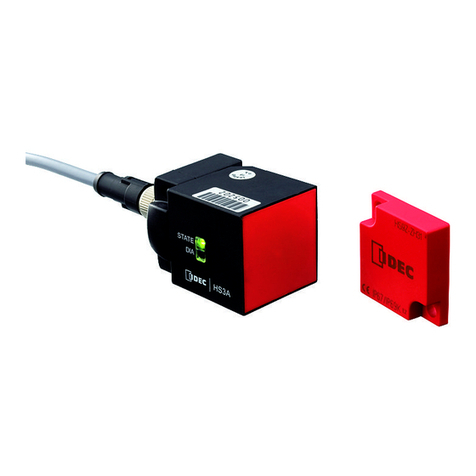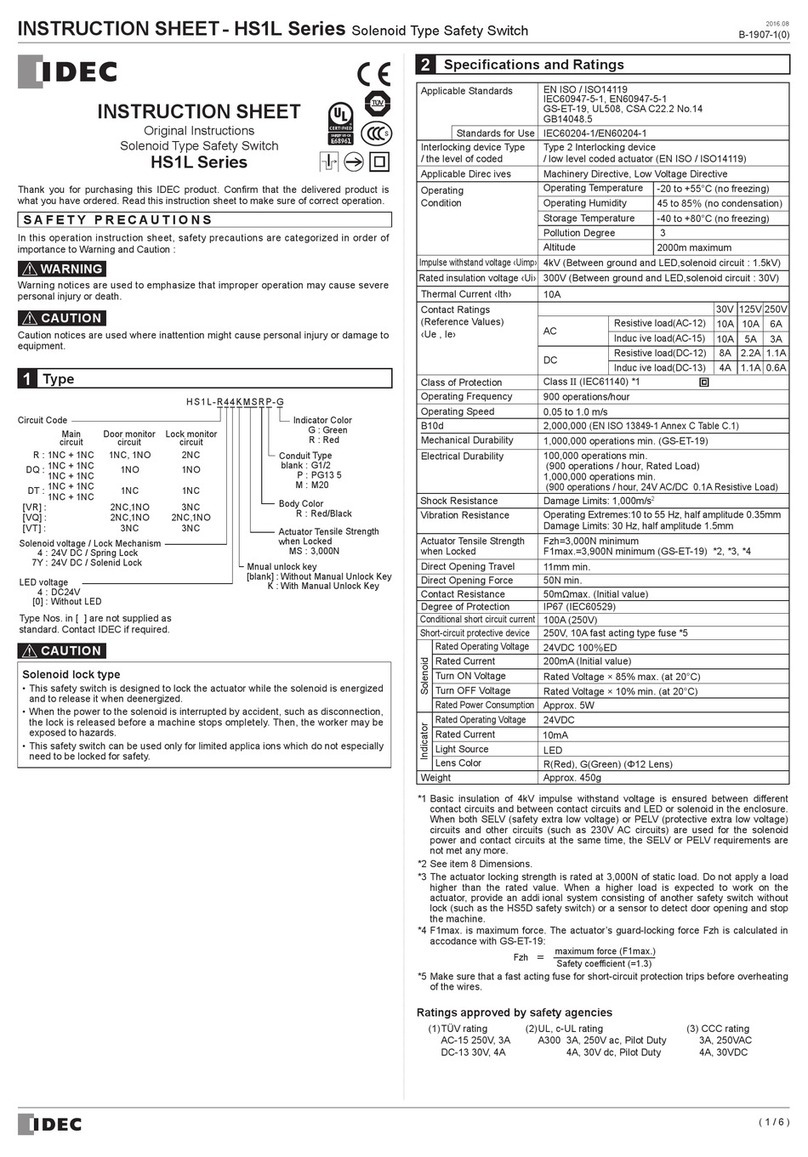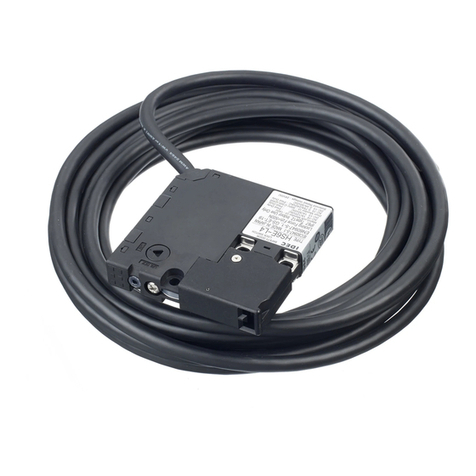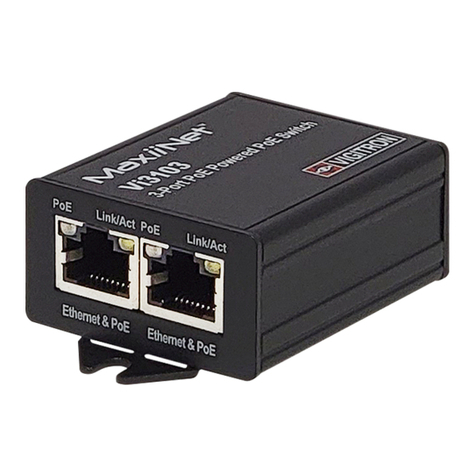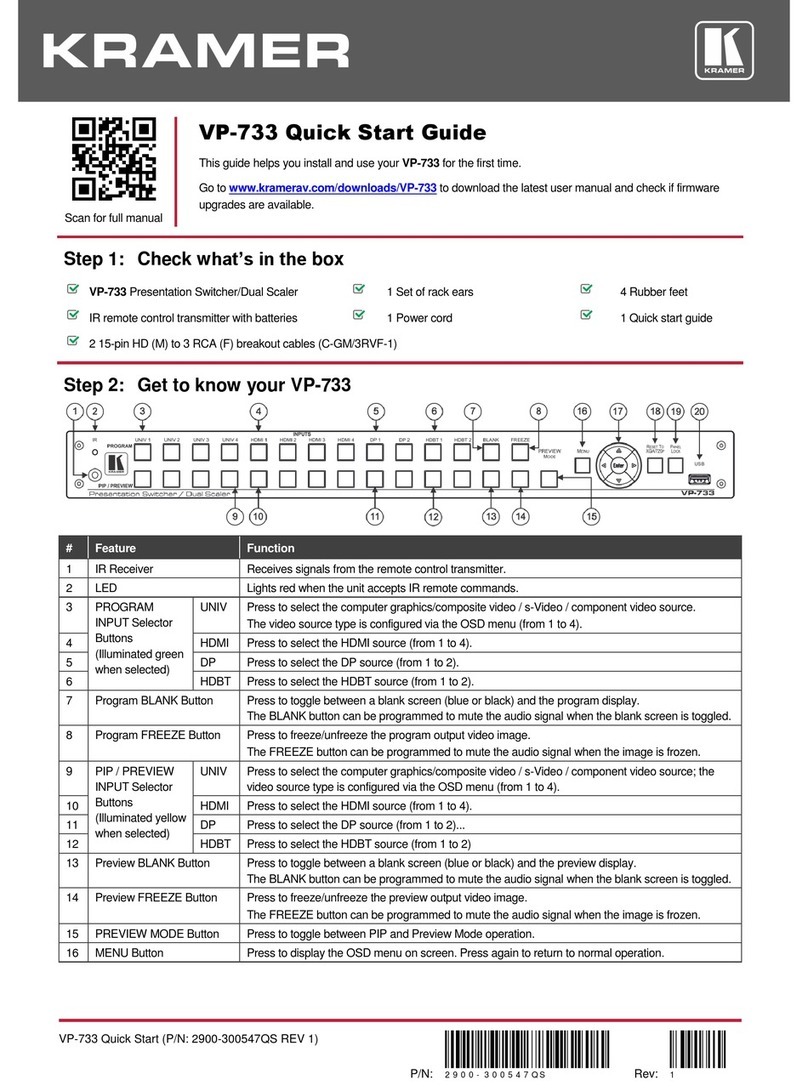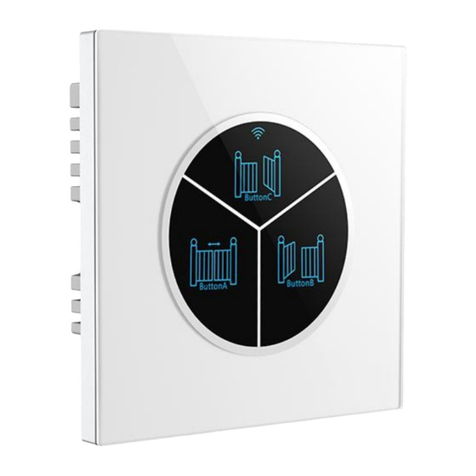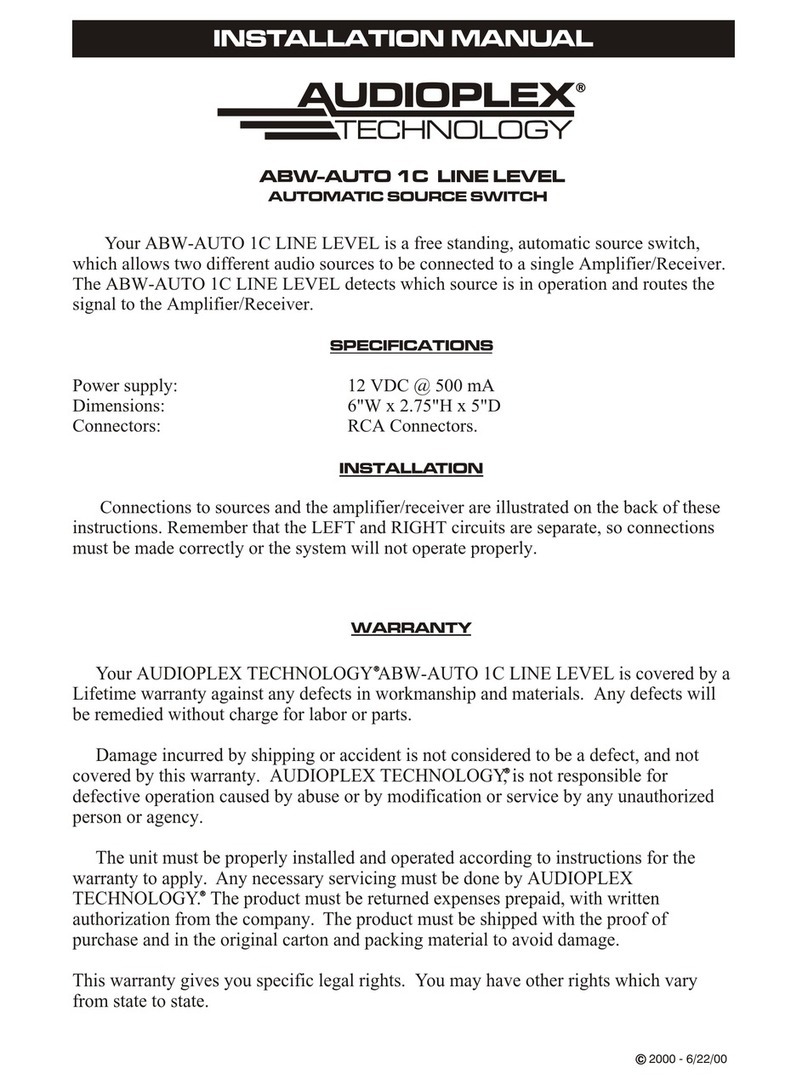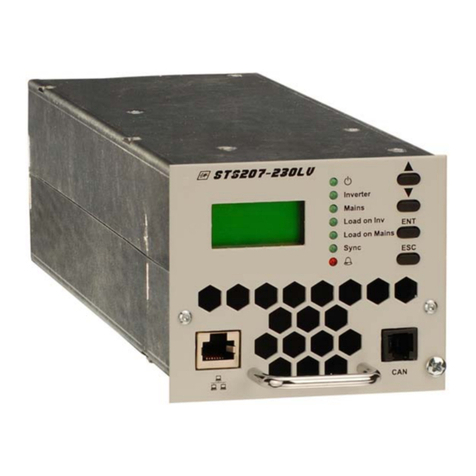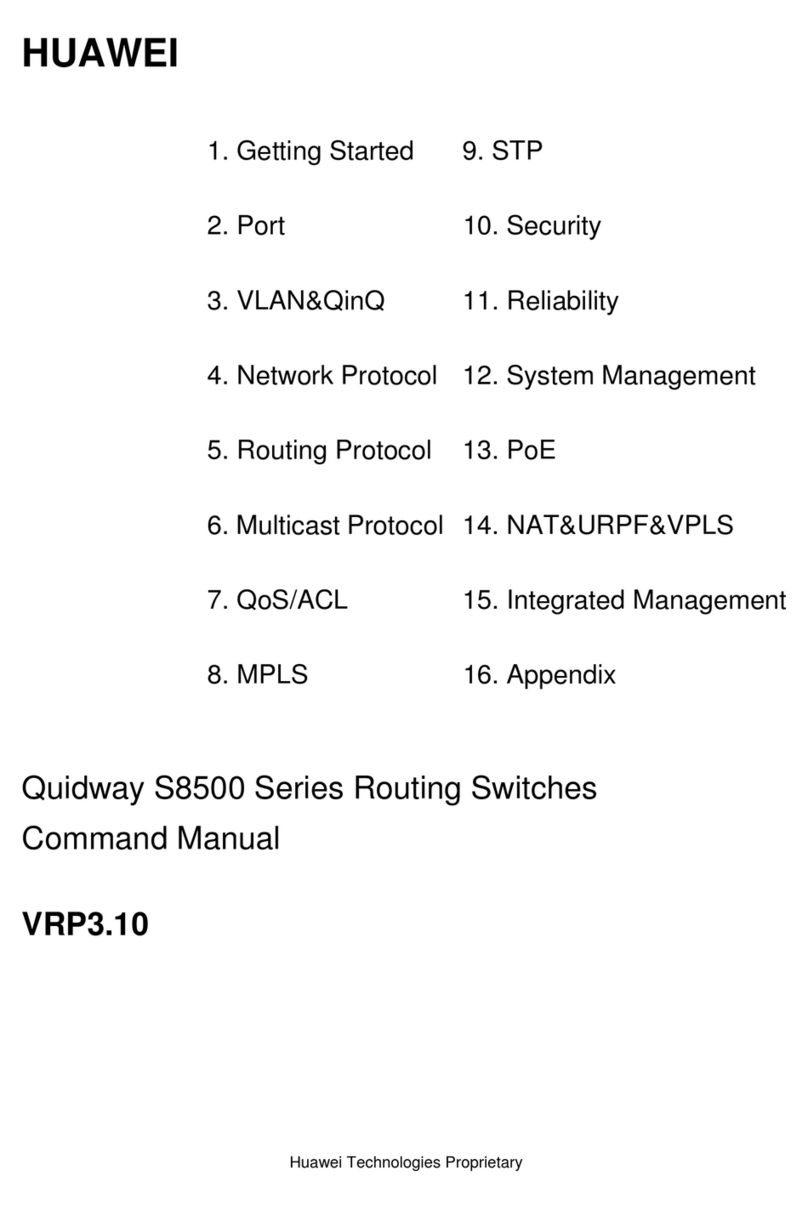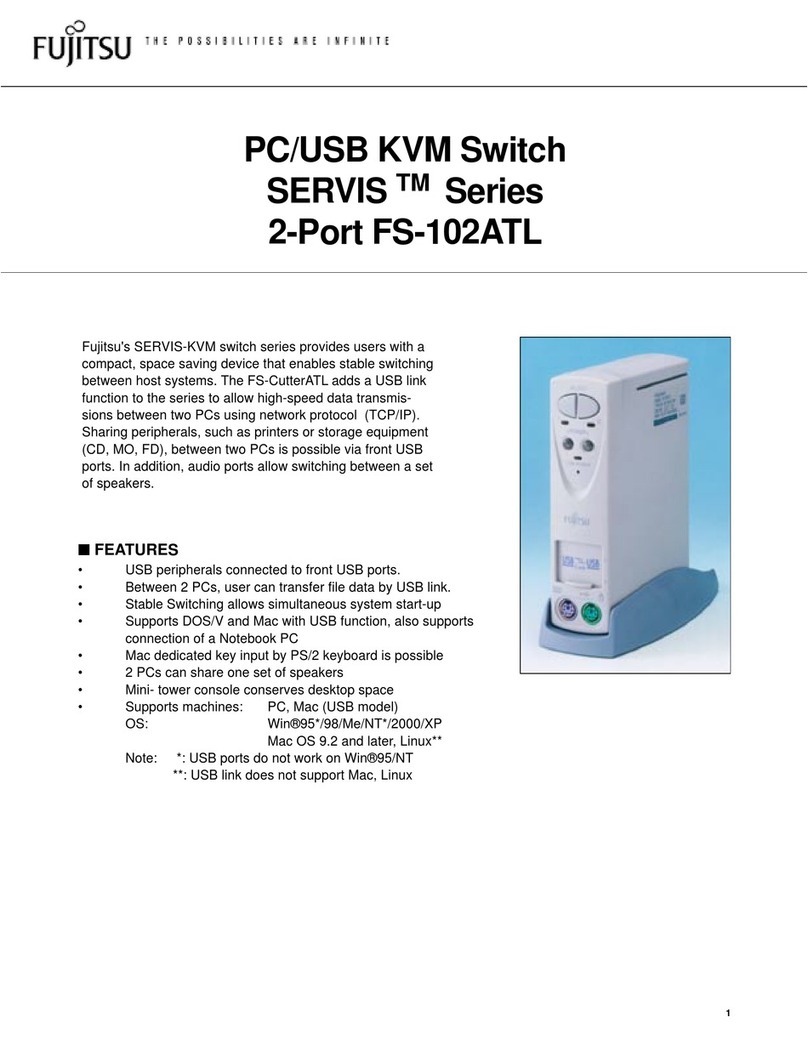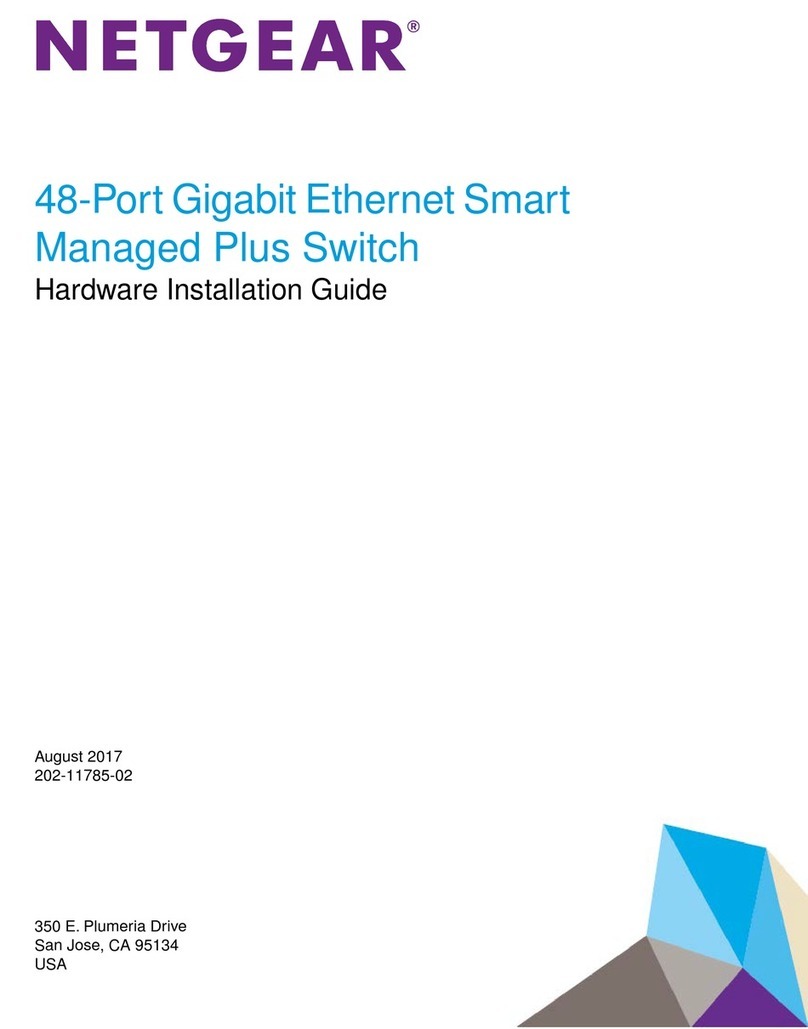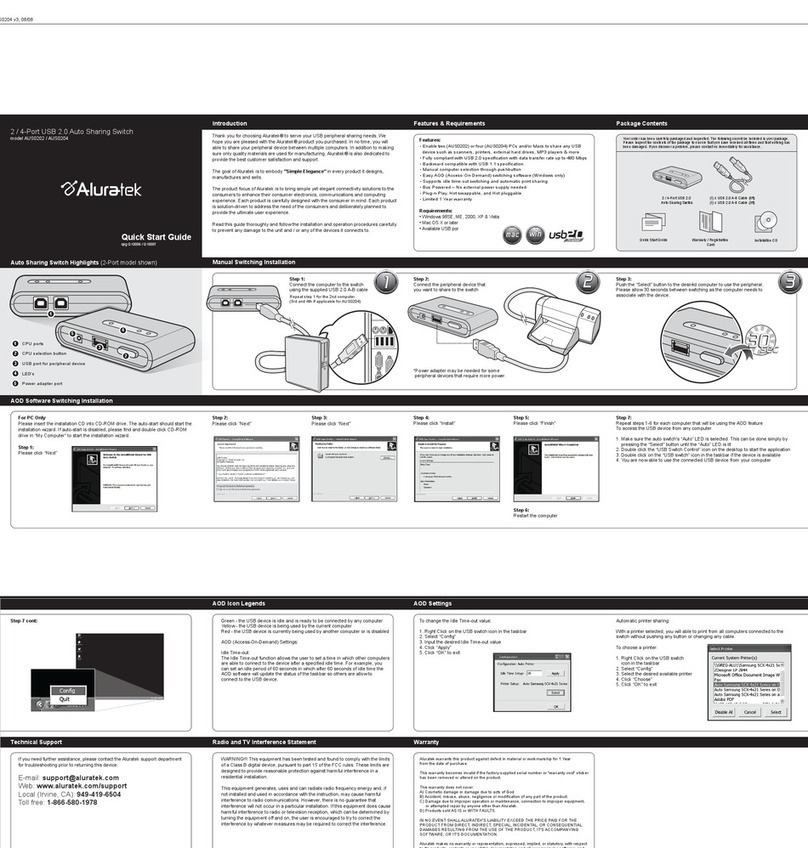IDEC HS6B Series User manual

B-1905-1(2)
INSTRUCTION SHEET- HS6B Series Interlock Switch
( 1 / 4 )
2021.09
1Type
2Specifications and Ratings
Ratings approved by safety agencies
(1) TÜV rating
AC-15 240V/0.75A
DC-13 250V/0.27A
DC-13 30V/2.3A
(2) UL,c-UL rating
C300 0.75A, 240V ac, Pilot Duty
Q300 0.27A, 250V dc, Pilot Duty
(3) CCC rating
AC-15 240V/0.75A
DC-13 30V/2.3A
(4) KOSHA rating
AC-15 240V/0.75A
DC-13 250V/0.27A
Install the interlock switch on the immovable machine or guard,
and install the actuator on the movable door. Do not install both
interlock switch and actuator on the movable door, otherwise
failure will occur.
Note : When inserting an actuator into the slot, make sure to
arrange the shapes in the same direction, as shown
on the right.
Actuator Mounting Reference Position
As shown below, the mounting reference position of the actuator inserted into the
interlock switch is: The actuator stop touches the interlock switch lightly.
Note: After mounting the actuator, remove the actuator stop from the interlock switch.
Actuator Mounting Tolerance
• Mounting tolerance of the actua-
tor is 1.0mm from the center of
the actuator to up, down, right,
and, left.
• Make sure the actuator can be
inserted into the entry slot without
any issue.
Door Stop
Door Stop
Interlock Switch
HS9Z-A61
Actuator HS9Z-A65, A66
Actuator
Actuator Stop
Interlock Switch
Actuator Stop
* Make sure that a fast acting fuse for short-circuit protection trips before overheating of the wires.
Center
Interlock Switch
±1.0mm
±1.0mm
3Mounting Examples
2.5A
300V
4kV
2000m maximum
3 (Inside2)
-40 to +80°C (no freezing)
45 to 85%RH (no condensation)
-25 to +70°C (no freezing)
Low Voltage Directive, Machinery Directive,
RoHS Directive
IEC 60204-1/ EN 60204-1
GS-ET-15, UL508, CSA C22.2 No.14, GB/T14048.5
EN ISO / ISO 14119, IEC 60947-5-1, EN 60947-5-1
Resistive load(AC-12)
Inductive load(AC-15)
Resistive load(DC-12)
Inductive load(DC-13)
Weight
Short-Circuit Protective Device
Conditional short circuit current
Contact Resistance
Direct Opening Force
Direct Opening Travel
Electrical Durability
Mechanical Durability
B10d
Vibration Resistance
Shock Resistance
Electric Shock Protection Class
‹Ue, Ie›
( Reference Values )
Contact Ratings
Thermal Current ‹Ith›
Rated Insulation voltage ‹Ui›
Impulse withstand voltage ‹Uimp›
Condition
Operating
Applicable Directives
Standards for Use
Applicable Standards
Operating Temperature
Operating Humidity
Storage Temperature
Pollution Degree
Altitude
AC
DC
30V
-
-
2.5A
2.3A
125V
2.5A
1.5A
1.1A
0.55A
250V
1.5A
0.75A
0.55A
0.27A
Approx. 120g (at HS6B-03B01)
250V AC,10A fast acting type fuse *
50A (250V)
300 mΩ maximum (Initial value, at cable length 1m)
60 N minimum
8 mm minimum
(1,200 operations / hour)
1,000,000 operations min. (AC/DC 24 100mA)
100,000 operations min. (AC-12 250V•1.5A)
1,000,000 operations minimum (GS-ET-15)
2,000,000 (EN ISO 13849-1 Annex C Table C.1)
Damage Limits: 30 Hz, half amplitude 1.5 mm
Operating Extremes: 5 to 55 Hz, half amplitude 0.5mm
Operating Extremes: 300m/s2, Damage Limits: 1
,
000m/s2
Class II (IEC 61140)
Minimum Radius of Hinged Door
When using the interlock switch for a hinged door, the minimum radius of the applica-
ble door is shown in the following figures.
• When using L-shaped actuator (HS9Z-A62)
• When using angle adjustable actuator (HS9Z-A65/HS9Z-A66)
• When using angle adjustable actuator (HS9Z-A65/HS9Z-A66)
When the center of the hinged door is
on the extension line of the actuator
mounting surface.
When the center of the hinged door
is on the extension line of the contact
surface of actuator and interlock
switch.
Note: The figures shown above are based on the condition that the actuator enters
and exits the actuator entry slot smoothly when the door is closed or opened.
Since there may be deviation or misalignment of the hinged door, make sure of
correct operation in the actual application before installation.
Door
Hinge Door
Hinge
HS9Z-A62
230mm
Minimum Radius
Minimum Radius
230mm
Door
Hinge Door
Hinge
Minimum
Radius
Minimum
Radius
160mm
160mm
(Horizontal Adjustment) Door Hinge
Door Hinge
Door Hinge
Door Hinge
LABEL LABEL
70mm
Minimum Radius
70mm
Minimum
Radius
50mm
Minimum Radius
50mm
Minimum
Radius
HS9Z-A65
HS9Z-A66
(Vertical Adjustment) Door Hinge
Door Hinge
LABEL
Door Hinge
Door Hinge
LABEL
50mm
50mm
70mm
Minimum Radius
70mm
Minimum
Radius
HS9Z-A65
HS9Z-A66
Minimum Radius
Minimum
Radius
Interlocking device Type
/ the level of coded Type 2 Interlocking device
/ low level coded actuator (EN ISO / ISO 14119)
Operating Speed
Operating Frequency 0.05 to 1.0 m/s
1200 operations/hour
Degree of Protection IP67 (IEC 60529)
Confirm that the delivered product is what you have ordered.
Read this instruction sheet to make sure of correct operation.
In this operating instruction sheet, safety precautions are categorized to Warning and
Caution:
Warning notices are used to emphasize that improper operation may cause severe
personal injury or death.
Caution notices are used where inattention might cause personal injury or damage to
equipment.
INSTRUCTION SHEET
Original Instructions
Interlock Switch
HS6B Series
SAFETY PRECAUTIONS
CAUTION
WARNING
Contact Configuration
11:1NC-1NO
02:2NC
12:2NC-1NO
03:3NC
HS6B-11B01 HS9Z-A61
Interlock switch Actuator
Cable Length
01:1m
03:3m
05:5m
61:Straight(Mainly for sliding doors)
62:L-shaped(Mainly for hinged doors)
65:Horizontal / Vertical Adjustment(Note)
66:Horizontal / Vertical Adjustment(Note)
Note : Select an actuator that moves in the direction required by the hinged door and
interlock switch.
* In order to verify if the product
you are interested in is certified
with the S mark, please check
the following section on our
website: "List of type numbers
certified with the S mark"
※

B-1905-1(2)
INSTRUCTION SHEET- HS6B Series Interlock Switch
( 2 / 4 )
2021.09
• Actuator can move 2.1mm from the mounting position without affecting the contact
operation.
Deviation of
actuator position Deviation of
door position ≤2.1mm
+
Recommended Screw Tightening Torque
Adjusting the Angle Adjustable (vertical/horizontal) Actuator
• Using the angle adjustment screw (M3 hexagon socket set screw), the actuator
angle can be adjusted up to 20°(refer to dimensions).
• The larger the actuator angle, the smaller the applicable radius of the door swing.
After installing the actuator, open the door. Then adjust the actuator angle so that the
actuator enters the entry slot of the interlock switch properly.
• After adjusting the actuator angle, apply loctite or the like on the adjustment screw to
prevent loosening. Use screw locking agent that is compatible with the base material.
Base: PA66 (66 nylon) of glass reinforced grade
Angle adjustment screws: stainless steel
For mounting the interlock switch (M4 screw) *1
For mounting the actuator (M4 screw) *1
Screw Tightening Torque
1.0 to 1.5N•m
1.0 to 1.5N•m
Name or Use
2.1mm
HS9Z-A61, HS9Z-A62 ACTUATOR
• When there is a displacement of interlock switch and actuator, the actuator may hit
the entry lot of interlock switch too hard, thus damaging the entry slot and actuator.
The rubber cushions on the HS9Z actuator prevent the actuator from damaging the
entry slit by absorbing the shock with movement flexibility. Do not, however, exert
excessive shocks, otherwise the failure of interlock switch may be caused.
• The rubber cushions may deteriorate depending on the operating environment and
conditions. Immediately replace the deformed or cracked rubber cushions with new
ones.
4Instruction
Installation
• Do not apply an excessive shock to the interlock
switch when opening or closing the door. A shock to
the interlock switch exceeding 1,000 m/s2may cause
failure.
• Provide a door guide, and ensure that force is applied
on the interlock switch only in the actuator insertion
direction.
• Entry of foreign objects in the actuator entry slot may
affect the mechanism of the switch and cause a
breakdown. If the operating atmosphere is contaminated, use a protective cover to
prevent the entry of foreign objects into the switch through the actuator entry slots.
• Make sure to install the product in a place where it cannot be damaged. Make sure
to conduct a proper risk assessment evaluation before using the product, and use a
shield or a cover to protect the product if need be.
• Do not fasten and loosen the conduit at the bottom of the interlock switch.
• When wiring, make sure that liquid such as water and oil dose not intrude from the
tip of cable.
• When bending cable at wiring, secure the cable radius of 40mm at the minimum.
• Be sure to use the dedicated actuator only, and do not operate the HS6B interlock
switch with anything other than the dedicated actuator. Otherwise, the safety of the
system may not be maintained.
Minimum Radius
40mm
Conduit
*1 When the torque is not enough to recommended screw tightening torque, make
sure that the screw do not become loose by using adhesive sealants etc. to
keep right operation and mounting positioning.
CAUTION
WARNING
• Turn off the power to the interlock switch before starting installation, removal,
wiring, maintenance, and inspection on the interlock switch. Failure to turn power
off may cause electrical shocks or fire hazard.
• Do not disassemble or modify the switch. Also do not attempt to disable the
interlock switch function, otherwise a breakdown or an accident will result.
CAUTION
• HS6B Series Safety Switches are Type 2 low-level coded interlocking devices (EN
ISO / ISO 14119). The following system installation & mounting instructions are
EN ISO / ISO 14119 requirements to prevent function failure from the interlock
switch.
1. Using permanent fixing methods (e.g. welding, rivets, special screws...etc) to
prevent dismantling or de-positioning of the interlock device. However, perma-
nent fixing methods are not an adequate solution if you expect the interlock
device to fail during the machinery lifetime, or if you need to replace the prod-
uct in quick manner. In these situations, other measures (see 2.) should be put
in place to reduce the risks of function failure.
2. At least one of the following measures should be applied to prevent function
failure.
(1) Mounting the interlock device in a place out of reach from workers
(2) Using shielding protection to prevent physical obstruction of the device
(3) Mounting the interlock device in a hidden position
(4) Integrate status monitoring & cycling testing of the device to the control
system to prevent product failure.
• Regardless of door types, do not use the interlock switch as a door stop. Install a
mechanical door stop at the end of the door to protect the interlock switch against
an excessive force.
• Mount the actuator so that it will not hit the operator when the door is open,
otherwise injury may be caused.
• Pay attention to the management of spare actuator. Safety function of door
interlock switch will be lost in case the spare actuator is inserted into the interlock
switch.
Ensure that the actuator is firmly fastened to the door (welding, rivet, special
screw) in the appropriate location, so that the actuator cannot be removed easily.
• Do not cut or remodel the actuator, otherwise failure will occur.
• If multiple safety components are wired in series, the Performance Level to EN
ISO 13849-1 will be reduced due to the restricted error detection under certain
circumstance.
• The entire concept of the control system, in which the safety component is
integrated, must be validated to EN ISO 13849-2.
Installing the slot plug
(In the case of a standard sale model.Please check other models.)
Slot plug
・When not in use, close up the interlock switch actuator
entry slots with slot plugs to prevent dust from entering.
・The actuator entry slot on the top come closed up with
slot plugs at time of shipment. When replacing,
please use a small screwdriver as shown and replace it.

B-1905-1(2)
INSTRUCTION SHEET- HS6B Series Interlock Switch
( 3 / 4 )
2021.09
5Contact Operation
Identification of wire
• The identification of wire is made by the color and white line printed on the wire.
No.
1
2
3
4
5
6
Color of Insulator
Orange / White
Blue / White
Brown / White
Brown
Blue
Orange
Specifications of cable
• UL style 2464, 6c×No.20AWG, ( 80°C 300V )
Dummy Insulator (black)
Jacket
Colored Insulator
Identification of terminal numbers
• When wiring, the identification of terminal number on each contact is made by
colored wire.
• The following shows a safety (main) contact and an auxiliary contact for three
contacts and two contacts types.
• When wiring, cut unnecessary wires such as dummy insulator (black) and / or
unused wire to avoid incorrect wiring.
2NC
3NC
1NC-1NO
2NC-1NO
11
33 12
34
BU
OG BU / W
OG / W BU
OG BU / W
OG / W
11
31 12
32
11
21
31
12
22
32
11
21
33
12
22
34
BU / W
BN / W
OG / W
BU
BN
OG
BU / W
BN / W
OG / W
BU
BN
OG
6Wiring
7Example of wiring Diagram realizing Safety Category
S1: HS6B-12 Interlock Switch
S2: Start switch (HW Series Momentary)
S3: Safety limit Switch
ESC: Outside start condition
K3, 4: Safety Contactor
F1: Outside fuse of safety relay module at power supply line
Note: Use the monitoring device(Safety relay module) provided the capability to
detect a cross short circuit. The insulation of the cable has to withstand
environmental influences. If a control device other than the one shown in the
draft is used, the used control device has to be equipped with a cross short
circuit monitor.
Output Circuit Output Circuit
One of the example of
the circuit ; Safety
relay module, HR1S-AF
series manufactured
by IDEC CORPORATION
One of the example of
the circuit ; Safety
relay module, HR1S-AF
series manufactured
by IDEC CORPORATION
Example of a circuit diagram for Safety Category 4
(attainable PL = e)
Example of a circuit diagram for Safety Category 3
(attainable PL = d)
(Condition 1: To apply the fault exclusion of mechanical structural parts including the actuator
→ Make sure to use the product within the product specification range described in this
manual and the version of the manual provided with the product.)
(Condition 2: Documentation of the reason for the machine/equipment manufacturer to have
applied the fault exclusion based on ISO 13849-1, ISO 13849-2 or IEC 62061.)
DC24V
F1
K4
K3
DC0V
S1 S1
12
11
HR1S-AF Safety relay module
13
14
ESC
K4
K3 S2
S33 S34 13 23A1
S11
S22
14 24
A2
S12S21
34
33
DC24V
F1
K4
K3
DC0V
13
14
ESC
K4
K3 S2
S3
1
2
HR1S-AF Safety relay module
S33 S34 13 23A1
S11
S22
14 24
A2
S12 S21
22
21
12
11
34
33
22
21
L1(+)
N(−)
L1(+)
N(−)
Used as open/close
monitor of guard Used as open/close
monitor of guard
Guard Open Guard Open
HS9Z-A61 Actuator HS9Z-A61 Actuator
HS6B-12
Interlock Switch HS6B-12
Interlock Switch
Contact Configuration and Operation
1NC-1NO
HS6B-11□
HS6B-02□
HS6B-12□
HS6B-03□
Contact Configuration Contact OperationType
2NC
2NC-1NO
3NC
11
33 12
34
11
21
31
12
22
32
11
21
33
12
22
34
11
31 12
32
11-12
33-34
11-12
31-32
11-12
21-22
33-34
11-12
21-22
31-32
(Actuator Completely Inserted) (Actuator Pulled Out)
0.8 (Actuator Mounting Reference Position)
0 Approx. 5.8 Approx. 28.2
(Travel: mm)
Approx. 5.5
: Contact closed : Contact open

B-1905-1(2)
INSTRUCTION SHEET- HS6B Series Interlock Switch
( 4 / 4 )
2021.09
8Dimensions
*2 The actuator stop is used
when adjusting the actuator
position. Remove after the
actuator position is deter-
mined.
*3 The direction of adjustable
angle can be changed (verti-
cal or horizontal) bychanging
the insertion direction of the
joint (white plastic part). See
the figures below. Do not lose
the joints. Actuators do not
operate normallywithout a joint.
Joint
(Horizontal Adjustment) (Vertical Adjustment)
Factory default
(Supplied)
(Supplied)
(Supplied with actuator)
(Supplied with actuator)
(Supplied with actuator)
(Supplied with actuator)
13 28.2
7.5
2.5
15
34
25 16.8
5.5
2
20°
R2.1
20°
0.8
1.2
3.5
25
20°
20°
Type:HS6B-□
Interlock Switch
Mounting Hole Layout
(Can be installed either frontwards or
backwards)
2-M4 Screws
(Φ4.3 or M4 Tap)
Actuator
Stop *2
Actuator
Stop*2
Type:HS9Z-A61
Type:HS9Z-A62
Type:HS9Z-A65
Type:HS9Z-A66
Joint
Joint
Actuator Stop *2
(Horizontal Adjustment)
(Horizontal Adjustment) (Vertical Adjustment)
Angle Adjusting Screw
(M3 Hexagon Socket Set Screw)
Actuator Stop *2
Actuator Stop *2
Actuator Mounting Hole Layout
(Horizontal / Vertical Adjustment)
2-M4 Screws
(Φ4.3 or M4 Tap)
Actuator Mounting Hole Layout
(Straight, L-shaped)
2-M4 Screws
(Φ4.3 or M4 Tap)
Angle Adjusting Screw
(M3 Hexagon Socket Set Screw)
Angle Adjusting Screw
(M3 Hexagon Socket Set Screw)
Note: HS9Z-A65 and HS9Z-A66 are different in the insertion direction of the metal
key(180°).
Factory default *3
(Vertical Adjustment)
Angle Adjusting Screw
(M4 Holes)
Base
Base
Actuator Stop *2
(M3 Hexagon Socket Set Screw)
Factory default *3
9PrecautionforDisposal
Dispose of HS6B Interlock Switch as an industrial waste.
http://www.idec.com
Accessories dimensions
Dimensions
15
10.1
10.4
5.5
1
30.8
R2.2
(9)
78
(30.1±1)
30
1
( )14 50.8
35
0.8
(12.6±1)
0.8
(5)
20
(58)
(41.4)
22.6±1
0.8
40.1±1
(21.4)
(14)
(5)
0.8
20 to 22
35.9 28.2
(8.4)
14
3.5
1.2
2-Φ4.3
2-Φ9
14 15
14
28.2
1.2
14
13.1
(8.4)
3.5
34
14
2-Φ4.3
2-Φ9
(Supplied with actuator)
Actuator Stop *2
When
installed on
the door (5)
When installed on
the door (33.8)
When installed on
the door (5)
When not in use, close up the interlock switch actuator entry slots with slot plugs
to prevent dust from entering.
(The actuator entry slot on the top come closed up with slot plugs at time of
shipment. In the case of a standard sale model. Please check other models.)
The actuator entry slot on the top
The actuator entry slot on the side
DECLARATION OF CONFORMITY
We, IDEC CORPORATION declare under our sole responsibility that the product:
Description: Interlock Switch
Model No: HS6B
Applied Union harmonized legislation and references to the relevant harmonization standards used or
references the other technical specifications in relation to which conformity is declared.
Manufacturer: IDEC CORP.
2-6-64 Nishimiyahara Yodogawa-ku, Osaka 532-0004, Japan
EU Authorized Representative:APEM SAS
55, Avenue Edouard Herriot BP1, 82303 Caussade Cedex, France
Applicable EU Directive : Low Voltage Directive (2014/35/EU),
Machinery Directive (2006/42/EC), RoHS Directive (2011/65/EU)
Applicable Standard(s) : EN 60947-5-1, GS-ET-15, EN 50581
UK Authorized Representative: APEM COMPONENTS LIMITED
Drakes Drive, Long Crendon, Buckinghamshire, HP18 9BA, UK
Applicable UK Directive : Electrical Equipment (Safety) Regulations 2016,
Supply of Machinery (Safety)Regulations 2008,
The Restriction of the Use of Certain Hazardous Substances in
Electrical and Electronic Equipment Regulations 2012
Applicable Standard(s) :EN 60947-5-1, EN 50581
Other IDEC Switch manuals

IDEC
IDEC SX5E Series User manual

IDEC
IDEC HS1C Series User manual

IDEC
IDEC SX5E Series User manual
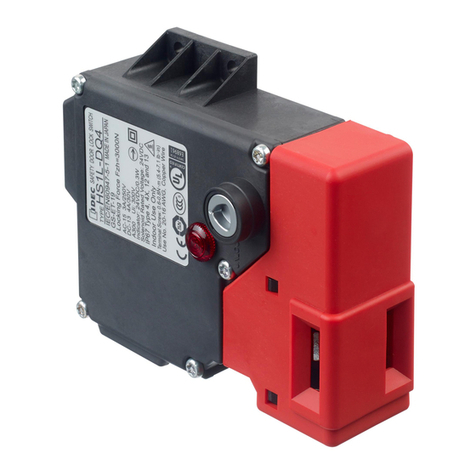
IDEC
IDEC HS1L Series User manual
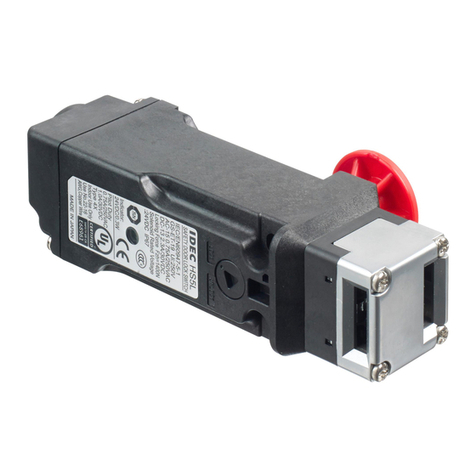
IDEC
IDEC HS5L Series User manual

IDEC
IDEC HS5L Series User manual

IDEC
IDEC SA1U Series User manual
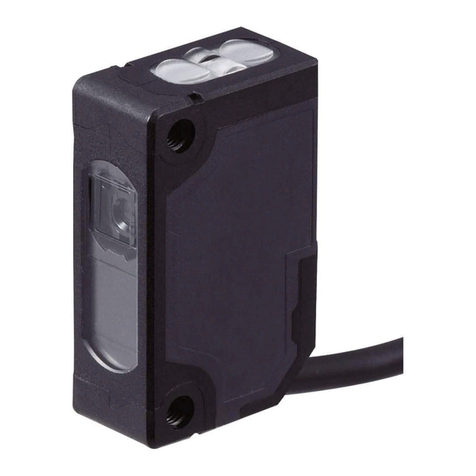
IDEC
IDEC SA1E-L Series User manual
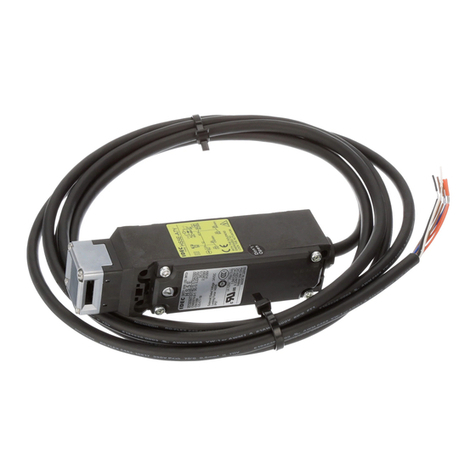
IDEC
IDEC HS5E Series User manual
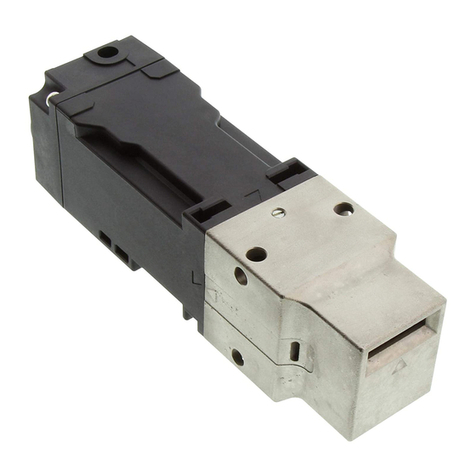
IDEC
IDEC HS1T Series User manual

IDEC
IDEC HS5E Series User manual
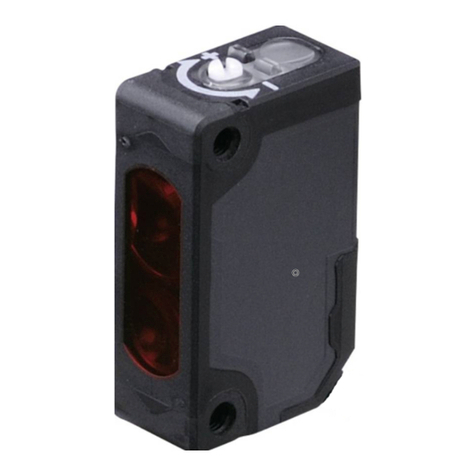
IDEC
IDEC SA1E Series User manual
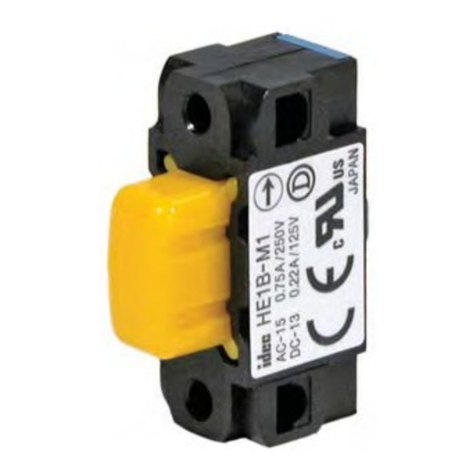
IDEC
IDEC HE1B Series User manual

IDEC
IDEC HS1E Series User manual
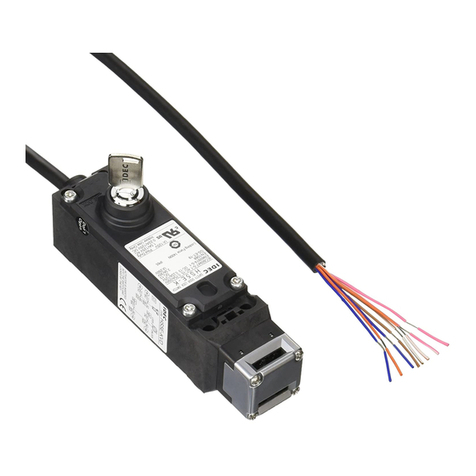
IDEC
IDEC HS5E-K User manual

IDEC
IDEC HS5E Series User manual

IDEC
IDEC SA1E Series User manual
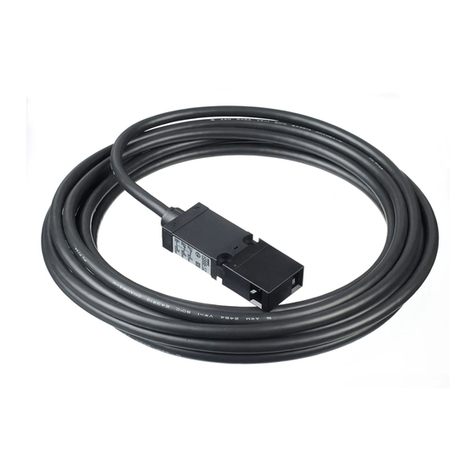
IDEC
IDEC HS6B Series User manual
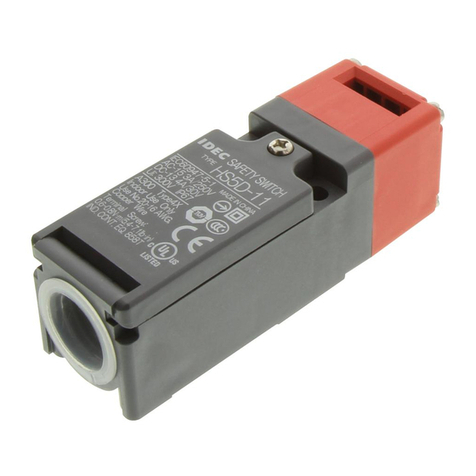
IDEC
IDEC HS5D-11 User manual
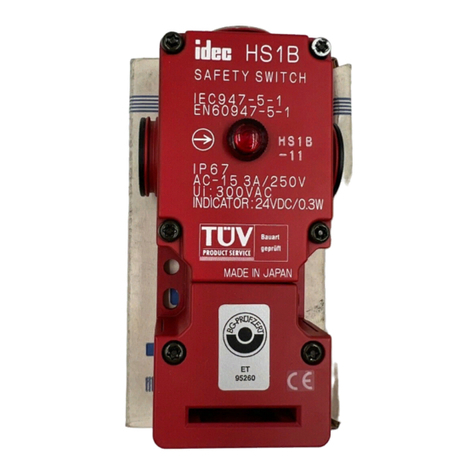
IDEC
IDEC HS1C Series User manual
